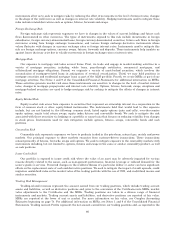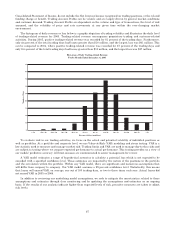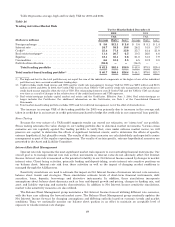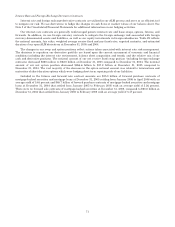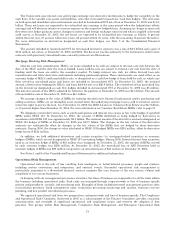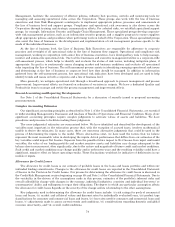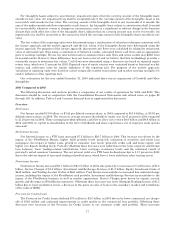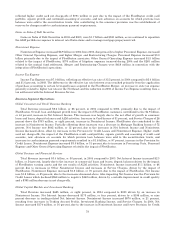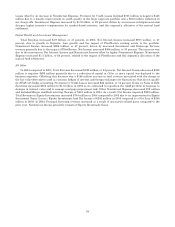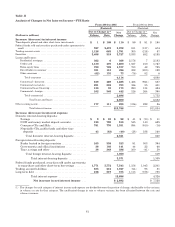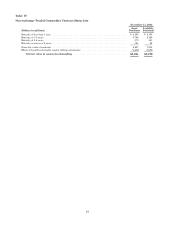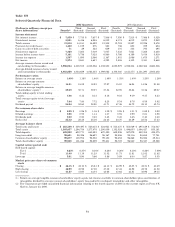Bank of America 2005 Annual Report Download - page 110
Download and view the complete annual report
Please find page 110 of the 2005 Bank of America annual report below. You can navigate through the pages in the report by either clicking on the pages listed below, or by using the keyword search tool below to find specific information within the annual report.Management, facilitate the consistency of effective policies, industry best practices, controls and monitoring tools for
managing and assessing operational risks across the Corporation. These groups also work with the line of business
executives and their Risk Management counterparts to implement appropriate policies, processes and assessments at
the line of business level and support groups. Compliance and operational risk awareness is also driven across the
Corporation through training and strategic communication efforts. For selected risks, we establish specialized support
groups, for example, Information Security and Supply Chain Management. These specialized groups develop corporate-
wide risk management practices, such as an information security program and a supplier program to ensure suppliers
adopt appropriate policies and procedures when performing work on behalf of the Corporation. These specialized groups
also assist the lines of business in the development and implementation of risk management practices specific to the
needs of the individual businesses.
At the line of business level, the Line of Business Risk Executives are responsible for adherence to corporate
practices and oversight of all operational risks in the line of business they support. Operational and compliance risk
management, working in conjunction with senior line of business executives, have developed key tools to help manage,
monitor and summarize operational risk. One tool the businesses and executive management utilize is a corporate-wide
self-assessment process, which helps to identify and evaluate the status of risk issues, including mitigation plans, if
appropriate. Its goal is to continuously assess changing market and business conditions and evaluate all operational
risks impacting the line of business. The self-assessment process assists in identifying emerging operational risk issues
and determining at the line of business or corporate level how they should be managed. In addition to information
gathered from the self-assessment process, key operational risk indicators have been developed and are used to help
identify trends and issues on both a corporate and a line of business level.
More generally, we mitigate operational risk through a broad-based approach to process management and process
improvement. Improvement efforts are focused on reduction of variation in outputs. We have a dedicated Quality and
Productivity team to manage and certify the process management and improvement efforts.
Recent Accounting and Reporting Developments
See Note 1 of the Consolidated Financial Statements for a discussion of recently issued or proposed accounting
pronouncements.
Complex Accounting Estimates
Our significant accounting principles as described in Note 1 of the Consolidated Financial Statements, are essential
in understanding Management’s Discussion and Analysis of Results of Operations and Financial Condition. Many of our
significant accounting principles require complex judgments to estimate values of assets and liabilities. We have
procedures and processes to facilitate making these judgments.
The more judgmental estimates are summarized below. We have identified and described the development of the
variables most important in the estimation process that, with the exception of accrued taxes, involves mathematical
models to derive the estimates. In many cases, there are numerous alternative judgments that could be used in the
process of determining the inputs to the model. Where alternatives exist, we have used the factors that we believe
represent the most reasonable value in developing the inputs. Actual performance that differs from our estimates of the
key variables could impact Net Income. Separate from the possible future impact to Net Income from input and model
variables, the value of our lending portfolio and market sensitive assets and liabilities may change subsequent to the
balance sheet measurement, often significantly, due to the nature and magnitude of future credit and market conditions.
Such credit and market conditions may change quickly and in unforeseen ways and the resulting volatility could have a
significant, negative effect on future operating results. These fluctuations would not be indicative of deficiencies in our
models or inputs.
Allowance for Credit Losses
The allowance for credit losses is our estimate of probable losses in the loans and leases portfolio and within our
unfunded lending commitments. Changes to the allowance for credit losses are reported in the Consolidated Statement
of Income in the Provision for Credit Losses. Our process for determining the allowance for credit losses is discussed in
the Credit Risk Management section beginning on page 49 and Note 1 of the Consolidated Financial Statements. Due to
the variability in the drivers of the assumptions made in this process, estimates of the portfolio’s inherent risks and
overall collectibility change with changes in the economy, individual industries, countries and individual borrowers’ or
counterparties’ ability and willingness to repay their obligations. The degree to which any particular assumption affects
the allowance for credit losses depends on the severity of the change and its relationship to the other assumptions.
Key judgments used in determining the allowance for credit losses include: (i) risk ratings for pools of commercial
loans and leases, (ii) market and collateral values and discount rates for individually evaluated loans, (iii) product type
classifications for consumer and commercial loans and leases, (iv) loss rates used for consumer and commercial loans and
leases, (v) adjustments made to assess current events and conditions, (vi) considerations regarding domestic and global
economic uncertainty, and (vii) overall credit conditions.
74




